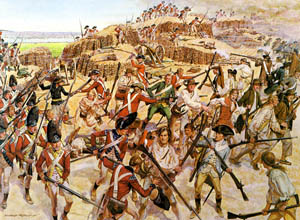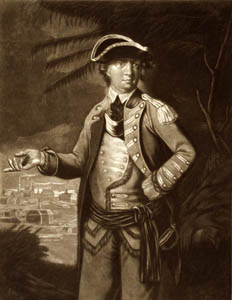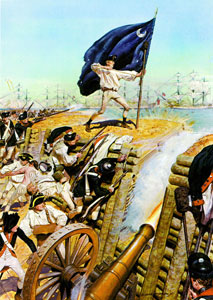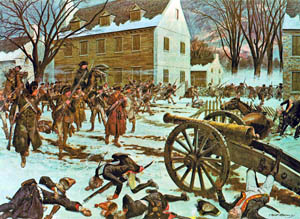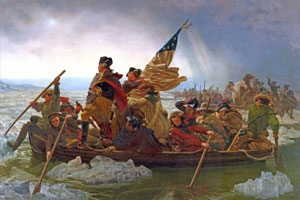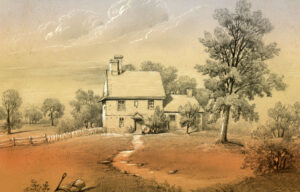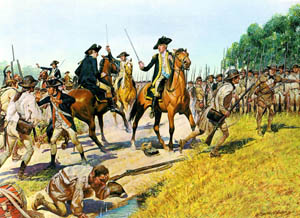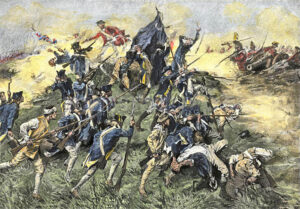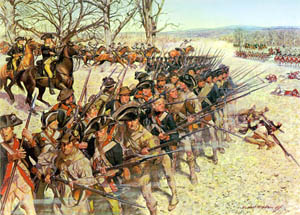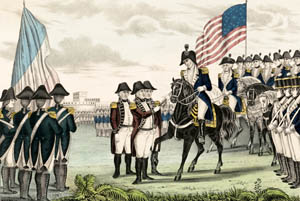Revolutionary War Campaigns – Legends of America (original) (raw)
George Washington’s triumphal entry into New York City, November 25, 1783, by Edmund & Ludwig Resteing, 1879.
In 1775, many of the inhabitants of Britain’s 13 American colonies rebelled in the War of Independence (1775-83). The British Army in America performed fairly well in the battle against the rebels. However, it could not prevent the loss of territory following French and Spanish entry into the war. During the war, an estimated 6,800 Americans were killed in action, 6,100 wounded, and upwards of 20,000 were taken prisoner. Historians believe that at least an additional 17,000 deaths were the result of disease, including about 8,000-12,000 who died while prisoners of war. While over 230 skirmishes and battles were fought during the American Revolution, these were the primary war campaigns.
Lexington, Massachusetts, April 19, 1775 – Opening hostilities of the Revolutionary War occurred at Lexington and Concord in Massachusetts on April 19, 1775, when a column of British troops moved out of Boston to seize rebel military stores at Concord was assailed by Minute Men and militia. The Massachusetts militia immediately placed the British in Boston under siege.
Ticonderoga, New York, May 10, 1775 – Opening hostilities of the Revolutionary War occurred at Lexington and Concord in Massachusetts on April 19, 1775, when a column of British troops that had moved out of Boston to seize rebel military stores at Concord was assailed by Minute Men and militia. The Massachusetts militia immediately placed the British in Boston under siege. At the same time, steps were taken to send an expedition against British-held Fort Ticonderoga on Lake Champlain. This strategic post was well-supplied with artillery and military stores, much needed by the American forces investing in Boston. Early on May 10, a New England force of some 80 men led by Colonels Ethan Allen of Vermont and Benedict Arnold of Connecticut surprised the British garrison of about 40 men, which surrendered without a fight. Following this success, Allen seized Crown Point on May 12, and Arnold temporarily occupied St. John’s, a fort across the Canadian border, on May 16. Subsequently, a large part of the 100 cannons and substantial military stores captured at Ticonderoga were laboriously hauled overland to Boston under the direction of Major General Henry Knox of Washington’s artillery to supply the army besieging the city.
Battle of Bunker Hill in Boston, Massachusetts.
Boston, Massachusetts, June 17, 1775 – March 17, 1776 – Also called the Battle of Bunker Hill. On the night of June 16, 1775, about 1,200 men of the Colonial force besieging Boston moved on to the Charlestown isthmus overlooking the city and threw up entrenchments on Breed’s Hill. The British garrison reacted promptly to this threat. On June 17, 2,200 troops under Major General William Howe were ferried to the isthmus and stormed the American positions on Breed’s Hill. In the ensuing battle, incorrectly named after Bunker Hill, which stands nearby, the British drove the Colonials from the isthmus after three assaults, but at a cost of about 1,000 killed and wounded as compared with American losses of approximately 400 killed and wounded. Some 3,030 patriots took part in the fighting at one time or another. This proved to be the only significant engagement of the prolonged siege of Boston. General George Washington formally commanded the besieging army on July 3, 1775. It devoted the next several months to building up the American force and trying to solve its severe logistical difficulties. By March 1776, Washington had an army of 14,000 men. On March 4, he moved suddenly to install artillery on Dorchester Heights and, a short time later, on Nook’s Hill, positions that dominated Boston from the South. The British commander, Howe, now recognized the serious difficulty of his position. He evacuated the city by March 17 and, on March 26, sailed with about 9,000 men for Halifax, Nova Scotia.
Colonel Benedict Arnold by Thomas Hart, 1776.
Quebec, Canada, August 28, 1775 – July 1776 – In June 1775, the Continental Congress, influenced by reports that the British commander in Canada was recruiting a force in preparation for an invasion of New York and by hopes that Canada, primarily inhabited by French, might become a fourteenth colony in support of the Revolution, authorized the seizure of any vital points in Canada needed to guarantee the security of the colonies. Consequently, a two-pronged invasion of Canada was launched in the early fall of 1775. Starting from Cambridge, Massachusetts, with about 1,100 men, Colonel Benedict Arnold went by water and land through the Maine wilderness on an epic march up the Kennebec and down the Chaudiere Rivers, arriving before Quebec on November 8 with only 650 men. There, he had to await the arrival of Brigadier General Richard Montgomery, who had taken over command of a force of about 2,000 men organized at Fort Ticonderoga by Major General Philip Schuyler for an advance up the historic Lake Champlain-St. Lawrence River route. Beginning on September 17, Montgomery laid siege to the British fort at St. Johns, which fell on November 2, opening the way to the American occupation of Montreal on November 13. Finally, Montgomery joined Arnold near Quebec on December 3, but with only 300 men, the rest of his force stayed behind to garrison St. Johns and Montreal. With enlistments of most of the volunteer troops expiring at the end of the year, the two commanders decided to undertake a desperate night attack on Quebec on December 30-31, 1775. A composite British garrison repelled the assault, killing or wounding about 100 Americans and taking over 400 prisoners. Montgomery was among those killed. Despite these severe losses, the Americans continued to besiege the city until the spring of 1776, when the reinforced British garrison drove the Colonials, who had already begun a retreat, back to the head of Lake Champlain.
Charleston, South Carolina, in the American Revolution.
Charleston, South Carolina, June 28-29, 1776, and March 29, 29 – May 12, 1780 – The two engagements at Charleston, South Carolina, were reflected on a single streamer. The first campaign blunted the British threat in the southern theater for three years, and the second, while a defeat for the Americans, did not result in a cessation of hostilities in the South. Guerrillas began to harry British posts and lines of communications, and the American grassroots strength began once again to assert itself and to deny the British the fruits of the military victory won in the field.
Long Island, New York, August 26-29, 1776 – After the British evacuation of Boston, Washington immediately moved his army, less the militia, to New York, anticipating a British invasion of that strategically important city. During July and August 1776, General Howe, supported by a British fleet under his brother, Admiral Lord Richard Howe, landed an army of 32,000 British and Hessian regulars unopposed on Staten Island. But by late August, Washington had assembled a force of over 20,000 virtually untrained Continentals and militia and built a system of defenses on and around Manhattan Island. About half of these Colonial troops were disposed in fortifications on Brooklyn Heights and forward positions at the western end of Long Island under the command of Major General Israel Putnam. From August 22-25, General Howe landed about 20,000 men on Long Island and, on the evening of the 26th, directed a broad flanking movement around the American left, commanded by Major General John Sullivan. On the morning of the 27th, Howe fell upon the rear of Sullivan’s forces and, despite a valiant defense by the Continentals on the right under Brigadier General William Alexander (Lord Stirling), the whole American front crumpled. Remnants of the forward American forces fled to entrenchments on Brooklyn Heights and, two nights later, were evacuated to Manhattan in a skillful withdrawal unobserved by the British. Estimates place American losses at 300-400 killed and wounded and 700-1,200 taken prisoners. General Howe listed his losses as 367.
Trenton, New Jersey, in the American Revolution.
Trenton, New Jersey, December 26, 1776 – The British followed up their success on Long Island with a series of landings on Manhattan Island, which compelled Washington to retire northward to avoid entrapment. When Forts Washington and Lee on the Hudson River above Manhattan were lost in mid-November 1776, Washington retreated across New Jersey with General Howe in close pursuit, finally escaping over the Delaware River into Pennsylvania with about 3,000 men. Howe then went into winter quarters in New York City, leaving garrisons at Newport, Rhode Island, and in several New Jersey towns. In December 1776, Washington surprised the British garrison in Trenton, a 1,400-man Hessian force, hoping that a striking victory would lift the badly flagging American morale. Reinforcements had raised Washington’s army to about 7,000, and on December 25-26, he ferried about 2,400 men of this force across the ice-choked Delaware River. At 8:00 a.m., they converged on Trenton in two columns, achieving complete surprise. After only an hour and a half of fighting, the Hessians surrendered. Some 400 garrison troops escaped southward to Bordentown, New Jersey, when two other American columns failed to cross the Delaware River to intercept them. About 30 were killed, and 918 were captured. American losses were only four dead and about the same number wounded.
George Washington Crossing the Delaware River by Emanuel Leutze.
Princeton, New Jersey, January 3, 1777 – After the successful coup at Trenton, Washington recrossed the Delaware River into Pennsylvania with his Hessian prisoners. But he reoccupied Trenton on December 3 -31, 1776, and collected a force of 5,200 men, about half of whom were militiamen. Meanwhile, Major General Charles Cornwallis, the British commander in New Jersey, who was in New York when the attack on Trenton, returned, gathering troops as he came. He entered Trenton with some 6,000 British regulars on January 2, 1877, and faced Washington’s forces, which had withdrawn southward behind Assunpink Creek. The Americans were in a precarious position with their backs to the Delaware River. Fortunately, Cornwallis delayed his attack until the following morning. This allowed Washington’s men to steal off quietly by a side road during the night of January 2-3, leaving their campfires burning brightly. They slipped southward and eastward undetected around the enemy’s flank. By the morning of January 3, they had arrived at Princeton, where they encountered a column of British regulars led by Colonel Charles Mawhood just leaving the town to join Cornwallis. In a brief engagement, the Americans defeated the British, inflicting losses of 400-600 killed, wounded, and prisoners for 30 patriots killed and wounded. Mawhood’s force retired in disorder toward Trenton and New Brunswick while Washington moved north to Morristown, where thickly wooded hills protected against a British attack. Here, he established his winter headquarters on the flank of the British line of communications, compelling General Howe to withdraw his forces in New Jersey back to New Brunswick and points eastward.
The American Revolution in Saratoga, New York.
Saratoga, New York, July 30 – October 17, 1777 – British overall strategy in 1777 had two primary objectives: (1) to split New England from the rest of the American states by a drive from Canada down the Hudson River to Albany that would link up with another British force advancing north from New York City, and (2) to seize Philadelphia, the seat of the Revolutionary government. The campaign in upper New York began in June 1777 with a two-pronged British drive from Canada. Major General John Burgoyne’s force of about 7,500, accompanied by some 400 Indians, pushed down Lake Champlain and compelled 2,500 Continentals and militia under Major General Arthur St. Clair to evacuate Ticonderoga on June 27. Under General Schuyler’s overall command, other American forces in the area retired southward. Still, they could slow the progress of the heavily laden British in the rugged terrain. The other prong of the British invading force consisted of some 700 regulars and Tories and a band of 1,000 Indians under the command of Colonel Barry St. Leger. This force moved east from Fort Oswego on Lake Ontario into the Mohawk Valley, intending to join with Burgoyne at Albany. Leger laid siege to Fort Stanwix, guarding the head of the Mohawk Valley, on August 2. However, he had to give up his campaign in mid-August when a relief force of 950 Continentals under Arnold scattered his Indian allies utilizing a clever ruse.
Meanwhile, Burgoyne continued his advance toward Albany. However, his force was further weakened by the near destruction on August 17 of a foraging detachment dispatched to capture stores at Bennington, Vermont, protected by 2,600 militia under Brigadier General John Stark. On September 13-14, Burgoyne crossed the Hudson River at Saratoga (now Schuylerville) and faced an American force of about 7,000 under Major General Horatio Gates, who, on August 19, had replaced General Schuyler as overall commander of the northern army. On September 19, Burgoyne, determined to reach Albany by winter, moved to attack Bemis Heights, where Gates’ force barred the route southward in firmly entrenched positions. A significant engagement occurred at Freeman’s Farm, just outside the main positions. The Americans yielded the field but inflicted twice as many casualties (600) as they suffered and held on to the Heights. For more than two weeks, Burgoyne remained inactive while Major General Sir Henry Clinton, now commanding troops in New York City, made an ineffectual effort to send relief forces up the Hudson River. Finally, on October 7, Burgoyne ventured out of his lines toward the American left with 1,650 troops and was repulsed in a sharp fight known as the Battle of Bemis Heights. On October 9, he retired to a position near Saratoga, where he was soon virtually surrounded by an American force now grown to nearly 10,000 men. On October 17, Burgoyne surrendered his army of about 5,000 men and large military stores.
George Washington’s headquarters in Brandywine, Pennsylvania, was built by Frederic Stevenson in 1856.
Brandywine, Pennsylvania, September 11, 1777 – The campaign to seize Philadelphia, the second major phase of British strategy in 1777, began in late July. Some 15,000 troops under Howe’s command sailed from New York on July 23 and landed at Head of Elk (now Elkton), Maryland, a month later on August 25. With about 11,000 men, Washington took up a defensive position blocking the way to Philadelphia at Chad’s Ford on the eastern side of Brandywine Creek in Pennsylvania. Howe attacked on September 11, sending Cornwallis across the creek in a wide-sweeping flanking movement around the American right while his Hessian troops demonstrated opposite Chad’s Ford. Major General Nathanael Greene’s troops staved off Cornwallis’ threatened envelopment of Washington’s whole force, and the Americans fell back to Chester in a hard-pressed but orderly retreat. Patriot losses in this engagement totaled about 1,000 killed, wounded, and prisoners. British casualties were less than 600.
Germantown, Pennsylvania, October 4, 1777 – After their victory at Brandywine, the British forces under Howe maneuvered in the vicinity of Philadelphia for two weeks, virtually annihilating a rear guard force under Brigadier General Anthony Wayne at Paoli on September 21, 1777, before moving unopposed into the city on September 26. Howe established his main encampment in nearby Germantown, stationing some 9,000 men there. Washington promptly attempted a coordinated attack against this garrison on the night of October 3-4. Columns were to move into Germantown from four different directions and begin the assault at dawn. Two columns, made up of militia, never appeared to participate in the attack, but in the early phases of the fighting, the columns under Greene and Divan achieved considerable success. However, a dense early morning fog, which resulted in some American troops firing on each other while it permitted the better disciplined British to re-form for a counterattack and a shortage of ammunition, contributed to the still not fully explained retreat of the Americans, beginning about 9:00 a.m. Howe pursued the Colonials a few miles as they fell back in disorder, but he did not exploit his victory. American losses were 673 killed and wounded and about 400 taken prisoner. British losses were approximately 533 killed and wounded.
The American Revolution in Monmouth, New Jersey.
Monmouth, New Jersey, June 28, 1778 – After the conclusion of the Franco-American Alliance (February 6, 1778), British forces in America had to consider the new threat created by the powerful French fleet. General Clinton, who relieved Howe as British commander in America on May 8, 1778, decided to shift the main body of his troops from Philadelphia to a point nearer the coast where it would be easier to maintain close communications with the British Fleet. Consequently, he ordered the evacuation of the 10,000-man garrison in Philadelphia on June 18. As these troops set out through New Jersey toward New York, Washington broke camp at his winter headquarters in Valley Forge and began pursuing Clinton with an army of about 13,500 men. Advance elements under Major General Charles Lee launched the initial attack on the British column as it marched out of Monmouth Courthouse (now Freehold), New Jersey, on June 28, an extremely hot day. For reasons not entirely clear, Lee did not follow up on the early advantages gained, and when British reinforcements arrived on the scene, he ordered a retreat. This encouraged Clinton to attack with his main force. Washington relieved Lee and assumed personal direction of the battle, which continued until dark without either side retiring from the field. But, during the night, the British slipped away to Sandy Hook, New Jersey, where their fleet took them to New York City. The British reported losses of 65 killed, 155 wounded, and 64 missing; the Americans listed 69 killed, 161 wounded, and 130 missing. General Lee was subsequently court-martialed and suspended from service for disobedience and misbehavior. Washington’s army moved northward, crossed the Hudson River, and occupied positions at White Plains, New York.
Siege on Savannah, Georgia, in the American Revolution by A. I. Keller.
Savannah, Georgia, December 19, 1778, and September 16 – October 10, 1779 – A single streamer represents the fighting at Savannah, Georgia, on these two occasions. In the first battle, a British expeditionary force that had landed on the Savannah River below the town overwhelmed and outmaneuvered the American defending force under General Robert Howe, and Savannah was captured. D’Estaing’s French fleet returned from the West Indies to the southern coast the following year. It began to debark troops at Beaulieu, 14 miles south of Savannah, to attack the British at Savannah. A combined force of 1,500 Americans under General Lincoln and more than 5,000 Frenchmen from D’Estaing’s fleet laid siege to Savannah, defended by about 3,200 British regulars. D’Estaing’s fears for the safety of the French fleet led to an early Franco-American attack on the entrenched British, which was repulsed with heavy casualties.
Cowpens, South Carolina, January 17, 1781 – Cowpens, South Carolina, was the scene of a classic battle, which marked the beginning of the American campaign under General Greene to drive the British from the South. In terms of duration and actual troops engaged, it was a more significant battle than Princeton, and its results – the destruction of an important part of the British army in the South – were incalculable toward ending the war.
Guilford Court House, North Carolina, in the American Revolution.
Guilford Court House, North Carolina, March 15, 1781 – Guilford Court House, North Carolina, was the site of the culminating battle in General Greene’s campaign against General Cornwallis. Although Greene lost the battle, Cornwallis’ forces were so depleted that he retreated to the coast and, from there, moved to Virginia, where he was ultimately to meet his fate at Yorktown.
Yorktown, Virginia, September 18 – October 19, 1781 – After 1778, the main theater of war shifted to the South as the British concentrated on re-establishing their control of that area. By 1781, they were convinced that this could not be accomplished while Virginia continued to serve as a base for American military operations. Hence, in January 1781, Clinton sent the American turncoat Benedict Arnold, with 1,600 British troops, to raid up the James River. By late May, the British had accumulated about 7,200 men in Virginia, including the remnants (1,500) of Cornwallis’ force, which had come up from Wilmington, North Carolina. Cornwallis was given overall command of British forces in Virginia and led them on raids deep into the state in late May and early June. At first, he was opposed only by a numerically significantly inferior force under the Marquis de Lafayette. However, in mid-June, troops reinforced the latter under Brigadier General Anthony Wayne and Baron von Steuben, drillmaster and inspector general of the Continental Army. Cornwallis then returned to the coast to establish a base at Yorktown, where he could maintain sea communications with Clinton in New York.
Major General Charles Cornwallis surrendered in Yorktown, Virginia.
Meanwhile, Washington was tentatively preparing his northern army, recently reinforced by about 4,800 French troops under Lieutenant General Jean B. de Rochambeau, for an attack on New York. However, he received confirmation on August 14 that Admiral Francois de Grasse’s fleet had departed the French West Indies with 3,000 troops aboard and would be available for operations in the Chesapeake Bay area until mid-October. Therefore, he finally determined to go to Virginia with a substantial part of his army, including the French regulars under Rochambeau. He crossed the Hudson River on August 20-26, made a feint in the direction of New York to hold Clinton in the city, and then struck southward across New Jersey and Pennsylvania to Maryland. In the meantime, De Grasse’s fleet arrived off Yorktown on August 30, debarked 3,000 French regulars to reinforce Lafayette, and on September 5, fought an indecisive naval engagement off the Virginia Capes with a British fleet under Admiral Thomas Graves. After several days of maneuvering at sea, Graves retired temporarily to New York for repairs, leaving the French fleet in control of Chesapeake Bay. This permitted Washington and Rochambeau to embark their forces in Maryland and sail via the Chesapeake and the James Rivers to a point near Williamsburg (September 14-24). From there, an allied army numbering about 15,000 — 8,845 Americans and 7,800 French moved forward on September 28 to begin siege operations against Yorktown. Finally, after a night attack on October 16 failed to recapture key defense points, Cornwallis requested an armistice on October 17. He surrendered his entire command-about 8,000 men-on October 19. In the siege, the British lost 156 killed and 326 wounded; the Americans, 20 killed and 56 wounded; and the French, 52 killed and 134 wounded. British hopes for victory in America collapsed with Cornwallis’ defeat. Lord North’s ministry fell in March 1782, and the new cabinet opened direct negotiations with the American peace commissioners in Europe, ultimately ending the war.
Compiled by Kathy Alexander/Legends of America, updated March 2024.

